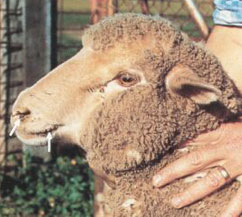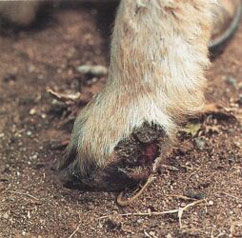Scabby mouth (orf)
Scabby mouth (contagious ecthyma, orf) is a highly contagious, viral disease of sheep, goats and occasionally humans. It occurs throughout Victoria.
This disease is a can impact live sheep exports due to the close confinement of animals.
How sheep are infected by scabby mouth
The scabby mouth virus infects a sheep through abrasions in the skin.
Cool, non-woolled areas such as the mouth, legs, feet, teats and poll are the usual sites of infection.
Sheep grazing stubble or on harsh feed are most susceptible to scabby mouth infection due to a higher incidence of minor injuries of the mouth and feet.
Diagnosing scabby mouth
A diagnosis of scabby mouth can be confirmed by laboratory examination of the scabs by electron microscopy but this is rarely necessary.
The mouth and feet are most affected.
At first small, reddened areas appear and begin to weep a clear fluid. This fluid eventually hardens into a thick brown scab. In the early stages the scab is firmly attached and if forcibly removed, a raw bleeding area is exposed.
After two to three weeks the scabs dry up and drop off. The underlying skin then heals rapidly.
In most cases the scabs appear at the corner of the mouth and muzzle. In severe cases they cover the lips and spread into the mouth and nostrils. Occasionally scabs occur around the eyes.

Scabs on the legs usually occur on the fetlock or coronet.

Scabs can also develop on the udder and teats of ewes. Affected ewes may not allow lambs to suckle resulting in lamb losses and reduced weight gain. Affected lambs may find it difficult to feed or suckle normally. Mastitis may also be a problem in a proportion of ewes.
Spread within the flock is usually rapid.
Sheep on board live sheep boats do not develop scabs as extensively as sheep in the paddock, however the lesions are unsightly and do affect the consistency and quality of the product reaching overseas markets.
Treating scabby mouth
The disease in sheep and goats is normally self-limiting and clears without treatment within 3 to 4 weeks.
Early manual removal of scabs will delay healing.
Antibiotics are not necessary unless secondary bacterial infection occurs.
Scabby mouth sores on the legs are susceptible to flystrike.
Leg lesions are most common in good seasons, when the legs are constantly exposed to long, wet pasture. The skin becomes macerated, and the virus then enters causing large scabby plaques. Leg and foot lesions may also occur when sheep graze stubble paddocks and the skin is damaged by the sharp stalks remaining after the crop has been harvested.
Affected sheep may be protected against fly strike by walking them through a footbath of jetting solution. Sheep with scabs around the mouth should be supplied with soft, lush feed to allow easier grazing, and to reduce trauma to the scabs while they heal.
Protecting sheep from scabby mouth
Animals that recover from scabby mouth develop a lifelong immunity to the disease. Sheep of all ages may become affected during the first outbreak on the property, but in subsequent years usually only the lambs are affected.
Vaccinating for scabby mouth
A scabby mouth vaccine is readily available and provides good protection from the disease.
The vaccine is applied to the bare skin on the inside of the thigh by scratching with a forked needle that has been dipped in vaccine. This causes a local reaction that does not spread. A line of pustules should appear along the scratch a week later – this indicates a good response and immunity from the vaccine. A sample of vaccinated sheep (about 10 per mob) should be checked between ten and fourteen days after vaccination to ensure a good 'take'.
Pregnant ewes should not be vaccinated within six weeks of lambing.
Never vaccinate ewes in the flank region before lambing.
Vaccination at this site may produce lesions on the udder, resulting in mastitis and an increased risk of transmitting scabby mouth to the lamb.
The recommended program for a property with continuing scabby mouth problems is to vaccinate each year's drop of lambs. This can be done at marking and will provide protection for up to 18 months.
Sheep intended for live trade with Southwest Asia and North Africa may require another vaccination before export.
Scabby mouth in humans
Humans occasionally become infected with the scabby mouth virus. The disease in humans is called orf.
The usual signs in humans are red papules, which are most often on the hands or arms. Shearers are sometimes affected in the armpit as a result of holding affected feet under their arms. Humans may also become infected from accidental inoculation of the scabby mouth vaccine.
Care should be taken to cover scratches and cuts before using the vaccine, and to not accidentally scratch fingers or hands with the vaccine applicator. Should an accident occur wash the site with disinfectant immediately.
More information
Further information on scabby mouth vaccination programs can be obtained from your local Animal Health and Welfare staff.